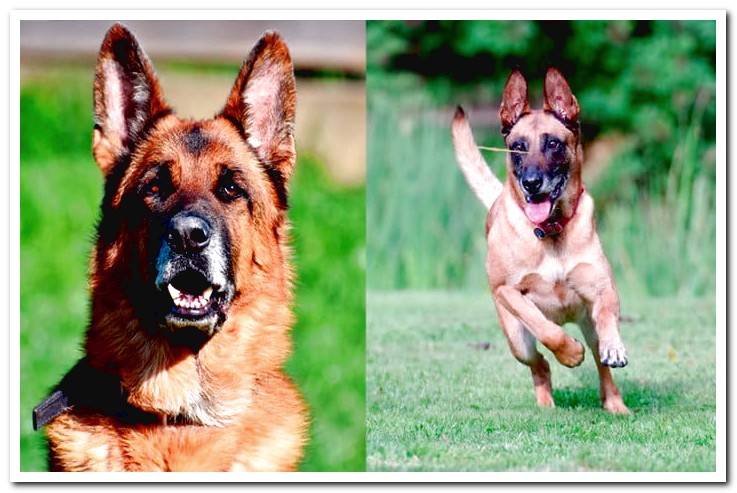
On many occasions, it is not easy to establish the differences between German Shepherd and Belgian Shepherd, since both dogs share characteristics. Medium size, raised ears and elongated muzzle are some of the similarities, but there are also some details that allow them to be differentiated.
Have you ever been confused when seeing one of these dogs? Let’s see what their main characteristics are to be able to differentiate them without problem at first visa. Ready @?
Index of contents
- 1 German Shepherd Characteristics
- 2 Belgian Shepherd Characteristics
- 3 How to differentiate a German Shepherd and a Belgian Shepherd
- 4 Care required by a Belgian or German Shepherd
German Shepherd Characteristics
Originally from Germany, it is among the best known dog breeds in the world. It is a medium dog with an elongated body. Male specimens measure from 60 to 65 centimeters at the withers, while their companions measure from 55 to 60 centimeters.
The head of this shepherd is proportional to the size of his body, it is wedge-shaped and the muzzle is slightly elongated. It has a black truffle, accompanied by a snout with a scissor bite. The eyes of this breed are almond-shaped and have an iris in light tones, such as yellow and greenish. The ears, on the other hand, are pointed up to form a triangle.
The fur of the German shepherd It can be short or long, both with a double mantle. The characteristic color is black with fire or gray spots; however, there are also black and gray German Shepherds, either pure or masked. In addition, the types of German Shepherd can be classified according to the work they do (work or company) and the place where the variety is developed, since there are Czech, American, Western and Eastern German shepherds.
The German Shepherd is a noble and protective dog, it performs well as a guardian. Furthermore, he is playful and obedient, he loves spending time with his masters and enjoying outdoor adventures.

Belgian Shepherd Characteristics
This sheepdog is native to Belgium, where it was used to guide flocks of sheep and fulfill guardian duties. It is medium and thin, but has great strength in the legs and torso. Males measure 62 centimeters at the withers, while females reach only 58 centimeters.
The head of the Belgian Shepherd It is straight and elongated, it has a black truffle and its snout with black lips hides a scissor or pincer bite. The eyes are almond-shaped and dark brown in color, framed by black eyelids.
The breed’s coat is heterogeneous, as there are several types of Belgian Shepherd. However, the Belgian Groenendael is similar to the German black, thanks to the color of the coat, while the black combination with fire or blonde is shown by the Malinois and Tervueren varieties. In these three types of Belgian Shepherd the coat is smooth and soft, long for the Malinois and Groenendael varieties, and short for the Tervueren.
The Belgian Shepherd, regardless of the color of the coat, is energetic and very playful, so it requires space to develop. Also, he needs training to channel his animosity and can develop as a guardian.

How to differentiate a German Shepherd and a Belgian Shepherd
At first glance it could be difficult to establish differences between German Shepherd and Belgian Shepherd, especially due to the varieties of fur that each breed presents. However, look at the following details to distinguish them:
- Origin: Although both dogs are shepherds, they were developed in different countries.
- Size: the Belgian Shepherd beats the German by a few centimeters.
- Bite: German Shepherds only present scissor bites, while Belgian ones also accept pincer bites.
- Eyes: Both races have almond eyes, but the German’s iris is always light and the Belgian’s dark.
- Ears: the shape is the same, but the ears of the German Shepherd tend to be more elongated.
- Tail: It is very similar in both breeds, but the tail of the Belgian Shepherd exceeds the hock, while that of the Belgian Shepherd does not.
- Shoulders: the shoulders join the shoulder blades in a similar way in both races, but in the Belgian they form an angle of 110 to 115 degrees, while in the German it reaches between 90 and 110 degrees.
Care required by a Belgian or German Shepherd
The different varieties of Belgian and German Shepherd require specific care. However, among the similarities of these breeds are the following needs:
- Both require a food for large dogs either with feed formulated for this size or homemade food with a good proportion of protein.
- Frequent physical exercise. These breeds are used to doing grazing and protection work, they need activities that test their physical abilities, are fun, and stimulate their intelligence through problem solving.
- Both require early socialization. Protective personality is necessary to train watchdogs; however, this can become a problem if not prosecuted as a puppy, since both Belgian and German develop possessive behaviors with their masters.
